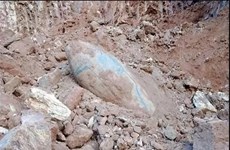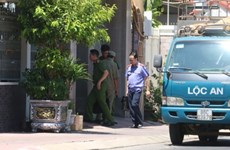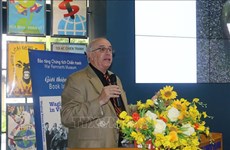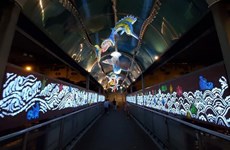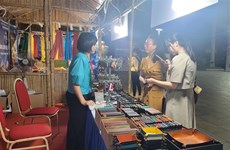Potentially unsafe toys flood Vietnam
Imported children's toys without safety stamps have overwhelmed the
domestic market and caught the eyes of little customers in the days
preceding International Children's Day June 1 despite a regulation for
quality stamps which was passed nearly one year ago.
Imported children's toys without safety stamps have overwhelmed the
domestic market and caught the eyes of little customers in the days
preceding International Children's Day June 1 despite a regulation for
quality stamps which was passed nearly one year ago.
In the Old Quarter along Hang Ma, Luong Van Can, Hang Can and Cha Ca streets, where most imported children's toys are sold, many children, escorted by their parents, were busily choosing gifts for their special day. Popular toys included dolls, figurines of cartoon characters, battery-operated toys and guns.
Quality stamps on the preferred toys were few and far between.
Trieu Thi Sinh, owner of a toy shop on Hang Ma street , said none of her customers asked about the stamps or the origin of the toys.
"They only cared about the design and the price. Some refused to buy certain toys, but most pampered their kids and bought them whatever they wanted," she said.
Sinh added that most of her toys were imports from China and cost between 10,000-55,000 VND (0.5-2.7 USD).
Nguyen Minh Hanh, mother of a five-year-old girl, said that she and other parents really wanted to buy certified safe toys for their children but the kids preferred the Chinese options because they were more colourful and diverse.
"The diversity of imported toys changes constantly to meet children's tastes. I just can't say no to them all the time," Hanh says.
Ly Phat Chanh, owner of the Hung Phat Toy Fitting Workshop in HCM City , said testing toys before getting the licence to sell them was costly.
"It costs us about 2 million VND (100 USD) to test a product, excluding the cost of printing the stamps. Then products need to be re-checked every six months," Chanh says.
This affects pricing. For example, a domestic Tosy flying saucer with a stamp costs 120,000 VND (6 USD) while the imported variety only costs 15,000 VND (0.75 USD), he says.
Nguyen Hung Dung, a chemical engineer at the Vietnam Science and Technology Institute, said materials developed for toy production must be chosen carefully as ‘the more colourful the toy is, the more harm it brings to your child'.
He said that many parents did not pay much attention to criteria, such as age and developmental ability recommendations, physical capability requirements and other warnings printed on toy labels.
Dung also advised parents to be sure the toys their children play with do not have the potential to cause them any harm. For example, coloured pencils should be free of chemicals and stuffed animals should be made of good quality materials.
Pham Phuong Thao, Chairman of HCM City People's Council, said there had been a lack of control on the toy market for years. Domestic enterprises needed support and control over the toy market needed to be tightened in the upcoming time, he said.
Last September, the Ministry of Science and Technology passed a regulation stipulating that all children's toys must be certified with CR (Conformity of Regulation) safety stamps. The regulation aimed to minimise risks to children.
Statistics from the Ministry of Industry and Trade reveal that over 90 percent of children's toys on the market are made in China . Only five percent of the toys are produced domestically.
According to the ministry, the quality of imported toys remains unknown./.
In the Old Quarter along Hang Ma, Luong Van Can, Hang Can and Cha Ca streets, where most imported children's toys are sold, many children, escorted by their parents, were busily choosing gifts for their special day. Popular toys included dolls, figurines of cartoon characters, battery-operated toys and guns.
Quality stamps on the preferred toys were few and far between.
Trieu Thi Sinh, owner of a toy shop on Hang Ma street , said none of her customers asked about the stamps or the origin of the toys.
"They only cared about the design and the price. Some refused to buy certain toys, but most pampered their kids and bought them whatever they wanted," she said.
Sinh added that most of her toys were imports from China and cost between 10,000-55,000 VND (0.5-2.7 USD).
Nguyen Minh Hanh, mother of a five-year-old girl, said that she and other parents really wanted to buy certified safe toys for their children but the kids preferred the Chinese options because they were more colourful and diverse.
"The diversity of imported toys changes constantly to meet children's tastes. I just can't say no to them all the time," Hanh says.
Ly Phat Chanh, owner of the Hung Phat Toy Fitting Workshop in HCM City , said testing toys before getting the licence to sell them was costly.
"It costs us about 2 million VND (100 USD) to test a product, excluding the cost of printing the stamps. Then products need to be re-checked every six months," Chanh says.
This affects pricing. For example, a domestic Tosy flying saucer with a stamp costs 120,000 VND (6 USD) while the imported variety only costs 15,000 VND (0.75 USD), he says.
Nguyen Hung Dung, a chemical engineer at the Vietnam Science and Technology Institute, said materials developed for toy production must be chosen carefully as ‘the more colourful the toy is, the more harm it brings to your child'.
He said that many parents did not pay much attention to criteria, such as age and developmental ability recommendations, physical capability requirements and other warnings printed on toy labels.
Dung also advised parents to be sure the toys their children play with do not have the potential to cause them any harm. For example, coloured pencils should be free of chemicals and stuffed animals should be made of good quality materials.
Pham Phuong Thao, Chairman of HCM City People's Council, said there had been a lack of control on the toy market for years. Domestic enterprises needed support and control over the toy market needed to be tightened in the upcoming time, he said.
Last September, the Ministry of Science and Technology passed a regulation stipulating that all children's toys must be certified with CR (Conformity of Regulation) safety stamps. The regulation aimed to minimise risks to children.
Statistics from the Ministry of Industry and Trade reveal that over 90 percent of children's toys on the market are made in China . Only five percent of the toys are produced domestically.
According to the ministry, the quality of imported toys remains unknown./.









